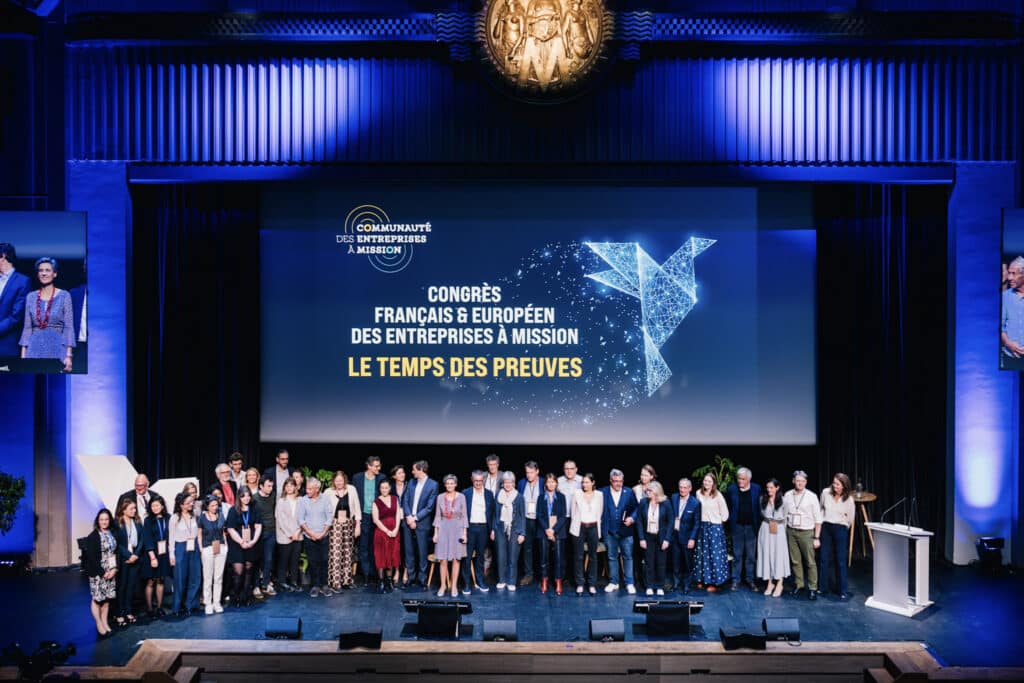Interview with Blanche Segrestin: The origins of the mission-driven company



French and European Mission Companies Congress at the Maison de la Mutualité on May 16, 2024. Crédit : Jean-Philippe Sanfaute
Five years ago, France’s Pacte Act introduced the status of mission-driven company, enabling businesses to set themselves ambitious social and environmental objectives, thereby broadening their economic raison d’être to include a contribution to the common good.
This innovative concept has its roots in the pioneering work of the Centre de Gestion Scientifique de Mines Paris – PSL, whose team of researchers Kevin Levillain, Stéphane Vernac and Errol Cohen played a key role under the direction of Blanche Segrestin and Armand Hatchuel.
In this interview, Blanche Segrestin looks back at the genesis of this concept and the impact of its application five years after the law was enacted. Discussing the legal nature and implications of the corporate mission, Blanche sheds light on the varied motivations of companies adopting this status, and analyzes the challenges and successes encountered.
At a time when the world is facing climate emergencies, the extension of the mission company statute on a European scale appears to be a crucial next step for governance aligned with objectives of sustainability and the common good.

Five years ago, the Pacte law was enacted, establishing the status of mission-driven company. This enables a company to set itself binding social and environmental objectives, and to broaden its economic raison d’être to include a contribution to the common good.
The concept stems from your work at the Centre de Gestion Scientifique de Mines Paris – PSL. Can you tell us how it came about?
The question of innovation dynamics has long been central to the work of the Centre de Gestion Scientifique (CGS). Today, the capacity for innovation is central to coping with transitions, but – and this was the starting point for our research on governance – it is neither taken into account nor protected by corporate legal frameworks. As a result, companies’ social and environmental ambitions, when they exist, are not protected. We therefore wondered how social and environmental goals could be incorporated into corporate governance frameworks.
Following the subprime crisis of 2008, we took part in a transdisciplinary research program at the Collège des Bernardins, alongside lawyers, historians and sociologists, on the nature of the crisis we had just experienced: was it a crisis of the financial markets or a crisis of corporate governance? Very quickly, we tackled the question of the legal framework for companies: how could non-financial goals be anchored in the company’s articles of association in a way that would be enforceable? The concept of the mission-driven company, with a body placed alongside the Board of Directors to oversee the process, was born.
We then pursued this research from 2015 onwards as part of the “Théorie de l’Entreprise. Models of governance and collective creation” and the publication of Kevin Levillain’s thesis in 2017 was an important culmination, along with, also, the creation of the mission-based enterprise community, at a conference at the École in 2018.
Today, there are more than 1,500 mission companies. What can we learn from these 5 years of implementation?
An observatory of mission-based companies has been created and will be set up in 2021 as part of a program run by the French National Research Agency.What’s most striking about the data collected is the wide variety of types of company that adopt the status of “mission company”: large corporations and SMEs alike, as well as social economy companies, cooperatives and so on…
I’m also struck by the heterogeneity of the reasons behind the decision to become a mission-driven company: for a family business, it may be a way of preserving its values and orientations at a time when its capital is being opened up. We also see companies adopting this status to initiate a transition and/or reinvent themselves. For complex organizations such as cooperatives with multiple subsidiaries, mission-driven status also enables commitments to be “propagated” across all components, including internationally. There are also sectors with particular challenges, such as the press, where governance could protect certain values, such as editorial independence.
Another noteworthy feature is the original way in which the Mission Committee operates. As it is a body that will discuss management choices, it seeks to go beyond stakeholder representation to include truly expert people, often academics.
In 2021, the ousting of the CEO of Danone, the first listed company to adopt this status, revealed some of its weaknesses. What lessons have been learned?
If anything, this example demonstrates the robustness of the system. Unprecedentedly, after Emanuel Faber’s departure, we saw coalitions between committed shareholders and trade unions asking directors to confirm their commitment to the mission. As a company with a mission, the company’s commitment has remained perennial. It is now up to the Mission Committee to play an important role in keeping the new management on its toes.
Against a backdrop of climate urgency, the “mission company” statute offers a form of governance that seems well-suited to the ecological transition of companies and industries. Is a Europe-wide extension of this status the next challenge?
The mission-driven company is particularly well-suited to the challenges of transition, as it enables companies to commit to a desirable future, but one that has yet to be built.Companies with a mission therefore engage in a design effort, with controlled governance, which seems indispensable for driving transitions.
At international level, there are numerous governance proposals for breaking away from the “short-termist” shareholder model. Most of them, however, propose either renouncing profit or demanding greater corporate transparency. But this does not guarantee a desirable future. The challenge is therefore to make the “mission-driven company” scheme more visible, particularly at European level.
To find out more :
Blanche Segrestin is a teacher-researcher at the Centre de Gestion Scientifique of Mines Paris – PSL, where she coordinates the work of the Théorie de l’Entreprise – Modèles de gouvernance & création collective chair. Her research focuses on a new theory of the firm based on innovation and its implications for law and governance.

Blanche Segrestin was awarded the 2019 HR Book Prize at the end of 2019 for her book co-authored with Kevin Levillain, “La mission de l’entreprise responsable – Principes et normes de gestion”.
